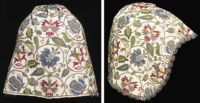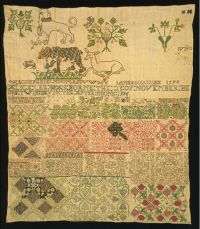Elizabethan Embroidery or

 |
In the transitory period between the death of Henry VIII and the ascension of Elizabeth 1 to the throne, there had been three rulers in England: Edward VII, Jane Gary, and Mary.
During the period of these three rulers, England was in turmoil and decoration on clothing was minimal, and much of the work was on undershirts and chemises and tended to be the Blackwork that had been so popular during Henry VIII's time.
Elizabeth ascended the throne in a blaze of colour and embroiderers throughout the country responded to this with a style of work that had not been seen before.
This style would turn into three distinct styles that are still alive today: crewel embroidery, Stumpwork embroidery and needlepoint.
The first "samplers" we have evidence of date from the Elizabethan times (not only in England but from Europe as well) and it is interesting to see that these samplers are truly stitch dictionaries, not pretty pictures and verses.
The most famous of these samplers is the "Jane Bostoke' sampler of 1597 on which we can see a huge number of techniques and also patterns.
 Jane Bostocke Sampler |
Elizabethans put embroidery everywhere - from clothing to bed hangings - nothing was untouched by the decorative needle.
We are fortunate in that the most common of items - the Swete Bag - survives in huge numbers and we can get an idea of the exquisite workmanship that was put into such an ordinary item.
The Victoria and Albert museum also has some beautiful examples of household linen and clothing done by the talented Elizabethan needleworkers.
Two of the most famous amateur embroiderers of this time were Mary Queen of Scots and the wife of her gaoler - Bess of Hardwick.
The Hardwick Hall textiles are a wonder of embroidery and the individual motifs (known as "slips") are full of allegorical meanings: many of which are very unflattering to Elizabeth I.
Another very important thing was happening during this time: printing had become well established and Printers were churning out Needlework Pattern books at a great rate. Many of these were re-printed in the 1800's and some of which have since been reprinted today by historical needleworkers.
I love Elizabethan Embroidery for its huge variety of styles and techniques. No matter what my mood is, I can always find something to do.
From the deceptive simplicity of Blackwork to the intricate padded embroidery and the fast slips all are fun to do and their techniques are easy to master.
As to the subtitle of this piece you may ask "Why?".
Well, the Elizabethan's believed in the "more is better" school of decoration, and Elizabethan Embroidery tends to cover all of the fabric with very little "white" space. In addition, they loved adding jewels, beads and spangles to everything.
I once saw a picture of a pillowcase that not only was embroidered using metal thread but also had beads and spangles on it. Imagine trying to sleep on that - OUCH!!!
The other thing that the Elizabethan’s loved was to include bugs amongst the floral decorations. No size differences were used – a bee was the same size as a tree! The inclusion of these fanciful creatures, as well as the combination of stylised and very realistic representations of plants and flowers gives this style a wonderful fantasy feel that still resonates today.
Links
Read Part 1
Recommended Reading
"Stumpwork Embroidery: A Collection of Fruits, Flowes and Insects for Contemporary Raised Embroidery" by Jane Nichols
"New Anchor Book of Crewelwork Embroidery Stitches" by Phillipa Turnbull
"Jacobean Iron On Transfer Patterns" by Linda Ormesson
Is there anything that you would particularly like to see an article on? If so, please contact me with your suggestions.
Happy Stitching

© 2007 Megan McConnell
This site needs an editor - click to learn more!
You Should Also Read:
Embroidery Forum
Embroidery Store
Related Articles
Editor's Picks Articles
Top Ten Articles
Previous Features
Site Map
Content copyright © 2023 by Megan McConnell. All rights reserved.
This content was written by Megan McConnell. If you wish to use this content in any manner, you need written permission. Contact
BellaOnline Administration
for details.


